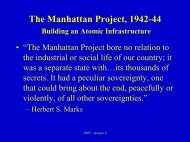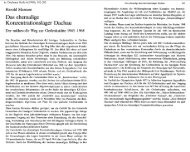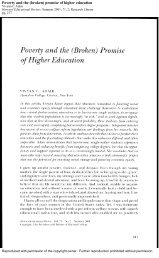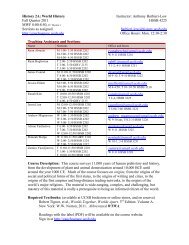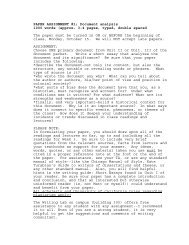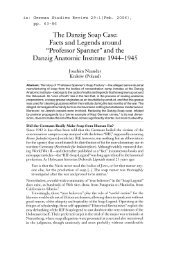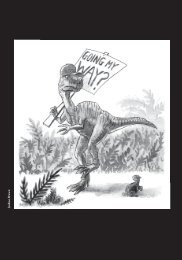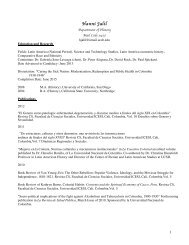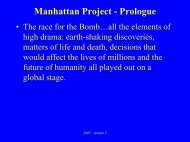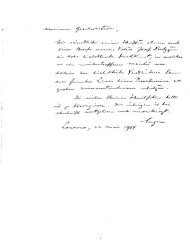DISASTER IN DARFUR - UCSB Department of History - University of ...
DISASTER IN DARFUR - UCSB Department of History - University of ...
DISASTER IN DARFUR - UCSB Department of History - University of ...
You also want an ePaper? Increase the reach of your titles
YUMPU automatically turns print PDFs into web optimized ePapers that Google loves.
1<br />
8,414 words; 29 pages<br />
<strong>DISASTER</strong> <strong>IN</strong> <strong>DARFUR</strong><br />
By<br />
Robert O. Collins<br />
Darfur (Land <strong>of</strong> the Fur) is the western region <strong>of</strong> The Republic <strong>of</strong> the Sudan<br />
(Jumhuriyat as-Sudan) approximately the size <strong>of</strong> France and divided into three<br />
administrative states that represent the three ethnic zones —northern, western, and<br />
southern—<strong>of</strong> Darfur. Northern Darfur State is the home <strong>of</strong> camel nomads, a small<br />
minority <strong>of</strong> whom are Meidab Arabs but the overwhelming majority are non-Arab<br />
Zaghawa. In the Western Darfur State on both sides <strong>of</strong> the volcanic Jabal Marra<br />
mountain massive towering 3,000 ft. (900 meters) above the vast Sudanic plain live non-<br />
Arab sedentary farmers, the Fur, Massalit, Daju, and Berti. Southern Darfur State is<br />
inhabited by the cattle and camel nomads, the Baqqara, who claim Arab (Juhayna)<br />
origins, speak Arabic but are ethnically the result <strong>of</strong> intercourse with their surrounding<br />
African neighbors after arriving in southern Darfur in the eighteenth century. All the<br />
peoples <strong>of</strong> Darfur are Muslims. A few Africans still practice their traditional religions<br />
whose vestiges can be found in the Darfurian symbiotic Muslim practices on this frontier<br />
<strong>of</strong> Islam. The rainfall and drainage from Jabal Marra onto the fertile soils <strong>of</strong> the western<br />
province support a vigorous agriculture by the African settled cultivators in stark contrast<br />
to the semi-desert <strong>of</strong> the north dependent for water on intermittent wadis and wells many<br />
<strong>of</strong> which go dry in the winter months. In the south the summer rains produce a rolling<br />
mantle <strong>of</strong> grass and reliable sources <strong>of</strong> water from wells and excavated reservoirs, hafri,<br />
for the Baqqara and their cattle.
2<br />
This bucolic description <strong>of</strong> cultivators and herdsmen peacefully tending to their<br />
traditional pursuits obscures the historic struggle for scarce resources by different people<br />
competing for land and water in Darfur. The past and most certainly the current crisis in<br />
Darfur cannot be understood without its history, a fact lamentably lost on the media and<br />
many <strong>of</strong> the non-Sudanese <strong>of</strong>ficials swept up in the Disaster in Darfur.<br />
Darfur in <strong>History</strong><br />
Historically, Darfur came into definition by the establishment <strong>of</strong> the sultanate in<br />
1650 whose foundations, however, rested on a centuries-old tradition <strong>of</strong> state formation<br />
dominated by the Fur and a ruling elite that included members <strong>of</strong> all the principal ethnic<br />
groups in Darfur. The Fur sultanate consisted mostly <strong>of</strong> non-Arab cultivators who<br />
employed the organized resources <strong>of</strong> the state and its heavy cavalry to contain the Arab<br />
nomads in their seasonal pastures well beyond Fur and Massalit agricultural lands. This<br />
equilibrium was not to last. In 1874 al-Zubayr Rahma Mansur, the Ja‘ali Arab slave<br />
trader who had created a personal fiefdom in the Bahr al-Ghazal in the southern Sudan,<br />
destroyed the Fur sultanate opening the pastures and cultivations to the Baqqara Arab<br />
nomads. When the British destroyed the Mahdist State in 1898, Ali Dinar, who had<br />
inherited the title <strong>of</strong> sultan in 1890, restored the Fur sultanate and spent most <strong>of</strong> the next<br />
eighteen years driving the Arab nomads north and south <strong>of</strong> the agricultural lands<br />
surrounding Jabal Marra that comprised the heartland <strong>of</strong> his sultanate. The only<br />
difference today in this historic struggle for the land is the ferocity <strong>of</strong> the killing by the<br />
kalisnikov rather than the spear or sword.<br />
In 1916 Ali Dinar, who had been sympathetic to the Ottoman Empire during the<br />
First World War, was killed by a British expeditionary force, and Darfur was annexed to
3<br />
the Anglo-Egyptian Condominium (1898-1956). The British soon learned that Darfur<br />
had little to contribute to the rebuilding <strong>of</strong> the Sudan. The principal city <strong>of</strong> El Fasher lay<br />
far to the west, and to this day there is neither an all-weather road nor a railroad to this<br />
historic capital. In 1959 Sudan Railways completed a line to Nyala, capital <strong>of</strong> Southern<br />
Darfur State 120 miles south <strong>of</strong> El Fasher, but its irregular service has never ended the<br />
region’s isolation. Darfur had no exploitive resources only subsistence cultivators and<br />
impoverished herdsmen. The administration consisted <strong>of</strong> a few resourceful British<br />
<strong>of</strong>ficers who kept law and order by ruthlessly enforcing gun control and little else leaving<br />
the day-to-day governance to local chiefs and shaykhs. The steady improvements in<br />
education and health care and the introduction <strong>of</strong> development schemes by British<br />
authorities in the greater Khartoum area along the Nile never made their way to Darfur.<br />
Peace, however, did produce an increase in the population that was resolved in a stagnant<br />
subsistence economy by the young men migrating eastward to find work in these new<br />
riverain development projects, particularly the vast Gezira cotton scheme south <strong>of</strong><br />
Khartoum between the Blue and White Niles. Once by the river, however, they also<br />
encountered discrimination by the awlad al-bahar (people <strong>of</strong> the river) for the awlad alghareb<br />
(people from the west).<br />
The perceived differences between those Sudanese living along the Nile in<br />
villages, towns, and cities and those from the rural hinterland run very silent but very<br />
deep in the past and present Sudan. The awlad al-bahar (sometimes awlad al-bilad) are<br />
the descendants <strong>of</strong> the Arab migrants into the Nile valley who were mostly Ja‘aliyyin (pl.<br />
<strong>of</strong> .Ja‘ali) who infiltrated into the heart <strong>of</strong> the Sudan in the sixteenth and seventeenth<br />
centuries. They became a sedentary urban society with a literate elite who during the
4<br />
fifty years <strong>of</strong> British rule became a sophisticated if not worldly ruling class that<br />
reinforced the disdain and derision <strong>of</strong> their grandfathers and fathers for the rustic illiterate<br />
folk from the West, East, and South. It was among these simple farmers and coarse<br />
herdsmen in the western Sudan <strong>of</strong> Kord<strong>of</strong>an and Darfur that the Umma Party <strong>of</strong> Sayyid<br />
Abd al-Rahman could count on support from his fervent followers, for his father,<br />
Muhammad Ahmad ibn Abdallah, the Mahdi, had recruited among the Baqqara and Fur<br />
the shock troops for his army that destroyed Egyptian rule in the Sudan and established<br />
the Mahdist State. They have remained passionately loyal to Mahdism, and after the<br />
independence <strong>of</strong> the Sudan in 1956 the Umma began to introduce selected sons <strong>of</strong> the old<br />
Darfur elite into the political life <strong>of</strong> Omdurman and Khartoum. Here they became<br />
assimilated into the ruling riverain awlad al-bahar or in the contemptuous words <strong>of</strong> the<br />
Darfurian political activist, Dr. Sharif Harir, they were corrupted by “riverization” after<br />
abandoning their traditional roots in Darfur for the political highlife <strong>of</strong> Khartoum.<br />
The ethnic and cultural discrimination by the riverain ruling elite in Khartoum for<br />
those Sudanese living on the periphery has historically established the pattern <strong>of</strong><br />
governance by the awlad al-bahar, which constitutes a circumference <strong>of</strong> no more than a<br />
few hundred miles from the confluence <strong>of</strong> the two Niles, and those lands beyond where<br />
the authority diminishes with the distance from the heartland. At no time in the last two<br />
hundred years has the central government <strong>of</strong> the Sudan—neither nineteenth century<br />
Turks or twentieth century British and certainly not the independent Sudanese—actually<br />
governed Darfur, the southern Sudan, or even the Red Sea Hills. Officials from the<br />
central government occupied the periphery with scattered symbolic posts in the<br />
countryside and a garrison and governor in the traditional capital, but at no time have
5<br />
they rigorously administered, effectively controlled, or demonstrated the usual<br />
characteristics associated with governance, good or bad. Geography was much to blame,<br />
for El Fasher is some 700 miles from Khartoum and Geneina on the Chad border another<br />
220 miles across plains <strong>of</strong> dubious quality stretching hundreds <strong>of</strong> miles around the<br />
mountain massive <strong>of</strong> Jabal Marra and crossed by ancient tracks whose reliability is<br />
largely determined by the weather, but the fundamental reason for fragile governance in<br />
Darfur remains the dearth <strong>of</strong> resources and political leadership from those in authority in<br />
the central government <strong>of</strong> Sudan who have preferred to adopt a policy <strong>of</strong> benign neglect.<br />
Historically, ethnic tensions between farmers and herdsman, African and Arab,<br />
latent and volatile, have always been present and accepted in Darfur but are exacerbated<br />
by long-standing competition for pasture, agricultural land, and water, the mundane<br />
matters so important in daily life in which verbal disputes can quickly erupt into violence.<br />
Quarrels over scarce resources became particularly acute during the great global drought<br />
<strong>of</strong> the 1980s that hastened the desertification <strong>of</strong> northern and central Darfur to produce<br />
increasing pressure on water and grazing as the camel nomads moved south in search <strong>of</strong><br />
both. The drought <strong>of</strong> the 1980s was not new just severe, and in the past the different<br />
ethnic groups had usually settled their disputes over land ownership and right to water<br />
wells by conferences, ajaweed/muatamarat al-sulh, <strong>of</strong> the traditional leaders whose<br />
rulings were invariably respected and honored. This mechanism began to breakdown<br />
when desertification was accompanied by the introduction <strong>of</strong> thousands <strong>of</strong> automatic<br />
weapons. By the 1990s Darfur was short <strong>of</strong> water but awash in guns.
6<br />
The Price <strong>of</strong> Impotence<br />
When the British departed in 1956, they left behind the Sudan Defense Force soon<br />
to become the Sudan Armed Forces (SAF). It was a disciplined, pr<strong>of</strong>essional, mobile<br />
army, the finest in the Middle East, equal to the Arab Legion <strong>of</strong> Jordan. In the Arab-<br />
Israel War <strong>of</strong> 1967 the Sudanese battalion sent to Sinai to help the Egyptians refused to<br />
retreat, disdained to surrender, and had to be annihilated before the Israeli advance could<br />
proceed. Moreover, the British found their best soldiers from the peoples <strong>of</strong> the<br />
periphery--the Nuba and Dinka <strong>of</strong> the southern Sudan and the Fur and Baqqara from<br />
Darfur who had established a reputation as warriors during the Mahdiya and their<br />
sporadic outbursts against the British--for the sons <strong>of</strong> the awlad al-bahar preferred the<br />
urban life <strong>of</strong> the riverain towns and a political or pr<strong>of</strong>essional career to the hardships and<br />
hazards <strong>of</strong> soldiering. In 1956 the army was, in fact, the only national institution in the<br />
Sudan and in the past half-century <strong>of</strong> Sudanese independence has intervened three times<br />
in 1958, 1969, and 1989 to seize power from incompetent, corrupt, and self-seeking<br />
political leaders democratically elected. At the time <strong>of</strong> their respective coups most<br />
Sudanese were delighted to see the politicians depart from government until later<br />
realizing the tyranny <strong>of</strong> military dictatorships that have ruled the Sudan for thirty-seven<br />
<strong>of</strong> its forty-eight years <strong>of</strong> independence. The decline <strong>of</strong> the Sudan Armed Forces began<br />
during the sixteen years <strong>of</strong> the rule <strong>of</strong> General Ja‘far Numayri (1969-1985) when the<br />
senior <strong>of</strong>ficers <strong>of</strong> the Sudan Defense Force were succeeded by younger, less pr<strong>of</strong>essional<br />
<strong>of</strong>ficers who could not resist abusing their authority for their own personal advancement<br />
at the same time fighting a war they could not win against the southern Sudanese<br />
insurgents. Moreover, the demise <strong>of</strong> a pr<strong>of</strong>essional Sudanese fighting force was
7<br />
accompanied by the creation <strong>of</strong> the People’s Defense Force (PDF) after the Islamist coup<br />
d’état <strong>of</strong> 1989 to make the army theologically correct but incapable <strong>of</strong> suppressing<br />
insurgencies.<br />
During the 1970s and 1980s the Islamic Charter Front (later the National Islamic<br />
Front, NIF) led by Hasan al-Turabi methodically recruited young <strong>of</strong>ficers at the military<br />
academy into NIF among them Omar Hassan Ahmad al-Bashir. When Bashir and his<br />
fellow Islamist <strong>of</strong>ficers seized power on 30 June 1989, the Revolutionary Command<br />
Council founded the PDF to protect the 30 June Revolution and to suppress the rebellion<br />
in the South essentially replacing the army as the instrument to enforce the Islamization<br />
<strong>of</strong> the Sudan. The soldiers for the PDF were not volunteers but conscripts by a very<br />
unpopular draft that numbered 150,000 recruits by 1991. They were introduced to<br />
weaponry by instructors from the Sudan army, but their indoctrination was more religious<br />
than military including interminable lectures on Islam. The ideological guide for the<br />
Islamist state, Hasan al-Turabi, made clear that it would be impossible to “Islamize” the<br />
Sudanese army because its pr<strong>of</strong>essional <strong>of</strong>ficers had been “secularized” that required a<br />
“large popular defense force” that would create an “Islamized” society. [“Islam,<br />
Democracy, the State and the West; Roundtable with Dr. Hassan Turabi,” Middle East<br />
Policy, vol. 1, no.3, 1992, pp. 49-61] This rabble in arms was to crush the battlehardened<br />
Nilotic veterans <strong>of</strong> the Sudan People’s Liberation Army (SPLA) in the southern<br />
Sudan and now in 2003-2004 the warriors from Darfur in the Sudan Liberation<br />
Movement/Army (SLM/A) and the Justice and Equality Movement (JEM).<br />
Neither the demoralized remnants <strong>of</strong> the old Sudan Armed Forces or the massive<br />
cannon fodder <strong>of</strong> the PDF were trained, equipped, or motivated to fight in the semi-
8<br />
deserts <strong>of</strong> the West or the swamps and rainforests <strong>of</strong> the South. They suffered successive<br />
defeats failing utterly to crush the insurgencies or to establish the authority <strong>of</strong> the Sudan<br />
government in these peripheral regions that produced the most fateful decision <strong>of</strong> the<br />
independent Sudan. In 1986 Prime Minister Sadiq al-Mahdi, great grandson <strong>of</strong> the<br />
Muhammad Ahmad, al Mahdi, leader <strong>of</strong> the Umma Party, and a dominant figure in<br />
Sudanese politics since the 1960s, decided to reverse the failure <strong>of</strong> the Sudan army to<br />
defeat the SPLA by arming with automatic weapons his Baqqara supporters on the<br />
southern Sudan frontier and giving them freedom to pillage, rape, enslave, and kill the<br />
Dinka across the Bahr al-Arab (the Kiir) River supporting the SPLA and its Dinka leader,<br />
John Garang. Riding their horses and brandishing their kalisnikovs the young Baqqara<br />
commandoes from the Missiriyya and Humr, known as the murahileen, wreaked havoc<br />
and death upon the Dinka <strong>of</strong> the Bahr al-Ghazal and the Upper Nile for the next ten years.<br />
The other large Baqqara group to the west in southern Darfur, the Rizayqat, also raided<br />
across the Dinka frontier to the south, but later turned this new and powerful weaponry<br />
against their northern African neighbors --the Fur, Massalit, and Zaghawa—with whom<br />
they had many ancient quarrels over space and water.<br />
After the Islamist coup d’état <strong>of</strong> 30 June 1989 the arming <strong>of</strong> the Baqqara<br />
murahileen continued under the illusion that these unruly, independent militias could be<br />
integrated into the PDF. More subtle but equally divisive to any settlement on the<br />
frontier <strong>of</strong> Islam was the determination by the regime to impose its Islamist ideology on<br />
all Sudanese and Arabic culture, language, and Islam as the foundation <strong>of</strong> Sudanese<br />
society when less than half the Sudanese claim Arab origins and another third were non-<br />
Muslims. The Arabo-centric enthusiasm <strong>of</strong> Bashir and his National Islamic Front (now
9<br />
the National Congress) government reopened old and deep wounds in Sudanese society.<br />
Throughout the centuries there has been by consent, intermarriage, or forced enslavement<br />
a mixing <strong>of</strong> African and Arab in the Nile Basin that has produced those unique<br />
individuals today known as the Sudanese. The sensible Sudanese are more concerned<br />
about their cultural heritage than their genetic purity, but the hardcore fervently seek<br />
through manufactured Arab genealogies their direct descent from the Prophet. The<br />
tragedy <strong>of</strong> the Islamist government <strong>of</strong> the Sudan injecting an ideological and racist<br />
definition as to whom is “Arab” in distinction from those who are zuruq, black, or the<br />
more pejorative epithet abid, slave, to distinguish between Arab and African and justify<br />
the killing, rape, and enslavement <strong>of</strong> these marginalized people by a cynical and<br />
dysfunction government in denial.<br />
The Crisis in Darfur<br />
On 26 February 2003 some 300 rebels calling themselves the Darfur Liberation<br />
Front (DLF) led by Abd al-Wahid Muhammad Ahmad Nur, a member <strong>of</strong> the Communist<br />
Party and the SPLM, seized the town <strong>of</strong> Gulu, capital <strong>of</strong> Jabal Marra Province in the state<br />
<strong>of</strong> western Darfur. Equipped with automatic weapons, mortars, and “technicals,” Toyota<br />
trucks with mounted machine guns made famous in the Chadian wars with Libya, they<br />
attacked scattered police and army posts before retiring to their training camps in Jabal<br />
Marra. Two weeks later the Darfur Liberation Front changed its name to the Sudan<br />
Liberation Movement/Army (SLM/A) and then “recaptured” Gulu in a fierce firefight<br />
killing 195 government soldiers and forcing the garrison to flee. Secretary-general <strong>of</strong> the<br />
SLM, Minni Arkou Minnawi, released to the press the Political Declaration <strong>of</strong> the SLM.<br />
Since the government <strong>of</strong> Khartoum has “systematically adhered to the policies <strong>of</strong>
10<br />
marginalization, racial discrimination, exclusion, exploitation, and divisiveness,” the<br />
objectives <strong>of</strong> the SLM are:<br />
a united democratic Sudan…predicated on full acknowledgment <strong>of</strong> Sudan’s<br />
ethnic, cultural, social, and political diversity. Viable unity must be therefore<br />
ultimately based on the right <strong>of</strong> self-determination….The fundamental<br />
imperatives <strong>of</strong> a viable unity are an economy and political system that address the<br />
uneven development and marginalization that have plagued the country since<br />
independence….Religion and politics…must be kept in their respective domains,<br />
with religion belonging to the personal domain and the state in the public<br />
domain….SPLM/A firmly opposes…the Khartoum Government’s policies <strong>of</strong><br />
using some Arab tribes…to achieve its hegemonic devices that are detrimental<br />
both to Arabs and non-Arabs….[Consequently], the brutal oppression, ethnic<br />
cleansing, and genocide sponsored by the Khartoum Government<br />
[have]left the people <strong>of</strong> Darfur with no other option but to resort to popular<br />
political and military resistance for the purpose <strong>of</strong> our survival. [The Sudan<br />
Liberation Movement and Sudan Liberation Army (SLM/SLA) Political<br />
Declaration]<br />
Within a few days the government security committee in western Darfur opened<br />
negotiations with the SLM, for the armed forces <strong>of</strong> the Sudan were insufficient and<br />
unprepared to fight a major insurgency in the West or isolate the insurgent’s camps in the<br />
Jabal Marra massive. The SLM presented five demands including an amnesty for the<br />
rebels and a pledge to implement development projects in Darfur under a fragile ceasefire<br />
that soon collapsed on 18 March when Arab militias assassinated near Geneina a<br />
respected Massalit leader, Shaykh Saleh Dakoro, followed two days later by helicopter<br />
gunships that destroyed much <strong>of</strong> Karnoi.<br />
The SLA retaliated on the 25 March, seized the strategic town <strong>of</strong> Tine on the<br />
Chad frontier, and captured large stocks <strong>of</strong> arms and equipment from its garrison.<br />
Thereafter, fighting raged throughout Western Darfur State in which the victories <strong>of</strong> the<br />
Sudan Liberation Army dramatically revealed the inadequacy and incompetence <strong>of</strong> the<br />
Sudan army. The best the Government <strong>of</strong> Sudan (GoS) could do was to blame the revolt
11<br />
on “gangsters” and “highwaymen.” On Friday 25 April an SLA force consisting <strong>of</strong><br />
thirty-three technicals staged a hit-and-run attack at the airport outside El Fasher, now<br />
capital <strong>of</strong> the Northern Darfur State, destroying helicopters, Antonov bombers, occupying<br />
army headquarters, and capturing air force Major General Ibrahim Bushra, . At the same<br />
time another SLA unit captured four tanks in clashes outside <strong>of</strong> Kutum seventy-five miles<br />
north <strong>of</strong> El Fasher. Ten days later the SLA captured Colonel Mubarak Muhammad al-<br />
Saraj, chief <strong>of</strong> intelligence for public security in Aynshiro north <strong>of</strong> Jabal Marra.<br />
In the attack on El Fasher the Sudan Liberation Army was joined by Darfurians<br />
from the Justice and Equality Movement (JEM) in what many in Darfur have called the<br />
“Opposition Forces.” There was little difference in the goals <strong>of</strong> these two resistance<br />
movements except the JEM “has come to rally all the peoples from the various regions <strong>of</strong><br />
the Sudan into a broad based and inclusive Movment,” not just Darfur. [“The Battle for al<br />
Fashir,” Press Release No. 5, Movement for Justice and Equality] Fighting now raged<br />
widely throughout Darfur. In late May the SLA north <strong>of</strong> Kutum destroyed a Sudanese<br />
battalion killing 500 and taking 300 prisoners. In mid-July they attacked Tine again<br />
leaving 250 soldiers dead. On 1 August they captured Kutum inflicting heavy casualties<br />
on the garrison before retiring after four days. The response to these victories by the GoS<br />
was to continue its denials that there was a resistance movement and rearm and unleash<br />
their Arab militias to rescue the army. Ironically this new war in the West provided the<br />
Islamist regime with new opportunities for its preservation. As the most unpopular<br />
regime in the history <strong>of</strong> the independent Sudan the government was now able to weaken<br />
any potential opposition by exploiting ethnic divisions, branding the insurgency as an<br />
African attempt to rid Darfur <strong>of</strong> the “Arab race” whose dominance was the very
12<br />
foundation <strong>of</strong> the Islamist government and its extremists groups like the “Arab<br />
Gathering.” Moreover, with the prospect <strong>of</strong> peace at Naivasha after twenty-two months <strong>of</strong><br />
negotiations with the SPLM, the new war in Darfur would keep the army preoccupied<br />
fighting instead <strong>of</strong> giving its disaffected <strong>of</strong>ficers the opportunity to plot a coup d’état and<br />
a pretext to purge the army <strong>of</strong> Darfurian <strong>of</strong>ficers in March 2004 by accusing them <strong>of</strong><br />
attempting to overthrow the government.<br />
The government militias were the former Baqqara murahileen now<br />
resuscitated as the janjaweed, or peshmerga as they are known in western Darfur, but<br />
unlike the murahileen <strong>of</strong> the 1990s who were Baqqara from southern Kord<strong>of</strong>an, the<br />
janjaweed <strong>of</strong> 2003 came from both the cattle Baqqara <strong>of</strong> southern and the camel Baqqara<br />
<strong>of</strong> central Darfur, but among them were strangers whom the local people suspected to be<br />
Arab extremists, perhaps Afghan-Arabs, or West African Muslims. The janjaweed began<br />
their ethnic cleansing as early as October 2002 from their camps in Jabal Kargu, Boni,<br />
and Idalghanam in southern Darfur with some 5,000 janjaweed in each where they were<br />
equipped and trained by the Sudanese army. The Fur, whom Salah Ali Alghali, the<br />
governor <strong>of</strong> southern Darfur openly vowed to exterminate, were singled out as the<br />
mounted janjaweed commandoes, usually 100 warriors, would sweep down on a village<br />
just before dawn. The pattern <strong>of</strong> destruction was the same. The men were killed, <strong>of</strong>ten<br />
mutilated, the women raped, and the children sometimes abducted. The village was<br />
burnt, the livestock seized, and the fields torched, and the infrastructure—wells, irrigation<br />
works, schools, clinics—methodically destroyed in a systematic scheme to drive the<br />
African population from their ancestral holdings. Ethnic cleansing means clearing the<br />
land for Arab colonization. By January 2003 a few hundred Fur had been killed and
13<br />
hundreds wounded, but tens <strong>of</strong> thousands had fled from the wasteland left by the<br />
janjaweed more units <strong>of</strong> which were now being trained in camps in Northern Darfur<br />
State. Little did the Africans know that these early attacks were but the prelude to the<br />
firestorm that was to sweep through Darfur after the victories <strong>of</strong> the “Opposition Forces”<br />
in the spring and summer <strong>of</strong> 2003.<br />
The janjaweed killing and displacement <strong>of</strong> Fur, Massalit, and Zaghawa escalated<br />
throughout the summer and autumn <strong>of</strong> 2003 supported by helicopter gunships and<br />
Antonov bombers, while the Sudan army defeated the SLA north <strong>of</strong> Kutum in late<br />
August with heavy losses including two <strong>of</strong> its leading commanders. In September the<br />
SLM signed a ceasefire proposed by the government <strong>of</strong> Chad that soon collapsed and<br />
both sides returned to the killing fields. Throughout the remainder <strong>of</strong> 2003 fighting raged<br />
particularly in western Darfur with rhetorical claims <strong>of</strong> victory by both sides and<br />
occasionally a reliable report. On 27 December the JEM ambushed a janjaweed column<br />
moving against the rebel-held town <strong>of</strong> Tine on the Chad border inflicting very heavy<br />
losses and in January 2004 repulsed another attempt to take Tine killing over a thousand<br />
government troops and militia. Increasingly, janjaweed columns would pursue and kill<br />
those they had evicted even crossing the Chad border to hunt down fleeing refugees. By<br />
February 2004, one year after the beginning <strong>of</strong> the insurgency, the conflict, ethnic<br />
cleansing, and displacement <strong>of</strong> Africans had conservatively claimed 30,000 lives, forced<br />
a million people from their lands as Internally Displaced Persons (IDPs), and sent another<br />
200,000 across the border into Chad. Another 350,000 Darfurians were expected to die<br />
within the next nine months from famine and disease when the rains arrived in late<br />
spring. James Morris, the Executive Director <strong>of</strong> the World Food Program, observed, “In
14<br />
all my travels as the head <strong>of</strong> the World Food Program, I have never seen people who are<br />
as frightened as those displaced in Darfur.” [“Sudan humanitarian crisis characterized by<br />
violence and fear,” UN News Centre, 7 May 2004]<br />
The International Community Struggles to Respond<br />
Although the numbers <strong>of</strong> IDPs and refugees steadily increased during the spring<br />
and summer <strong>of</strong> 2003 as the fighting escalated, it was not until September that the<br />
magnitude <strong>of</strong> the destruction and displacement began to be recognized by the<br />
international humanitarian agencies. In October Médicines Sans Frontières reported that<br />
thousands <strong>of</strong> IDPs had been traumatized by the violence, but when the UN and other<br />
humanitarian agencies sought entrance into Darfur to assess and relieve the suffering they<br />
were met with manipulative obstruction from the Khartoum government. The UN<br />
humanitarian coordinator in the Sudan, Mukesh Kapila, bitterly complained about slow<br />
and cumbersome travel procedures and, “in some cases, permission to visit affected areas<br />
is withheld…[he] warned that the situation in the Greater Darfur Region <strong>of</strong> western<br />
Sudan may emerge as the worst humanitarian crisis in the Sudan since 1998.”<br />
[“Statement from UN Humanitarian Coordinator for Sudan,” Nairobi/Khartoum,<br />
November 10, 2003] By the end <strong>of</strong> November the international relief agencies were<br />
thoroughly alarmed “about a looming food crisis in western Sudan” particularly when the<br />
Ministry <strong>of</strong> Agriculture refused food aid for Darfur from the US Agency for International<br />
Development (USAID). [Agence France-Presse, November 14, 2003; Kamal al Sadiq in<br />
Al-Ayam, November 16, 2003, no. 7825] In December the UN secretary-general’s<br />
Special Envoy for Humanitarian Affairs for Sudan, Tom Vraalsen, was more than blunt.<br />
“Delivery <strong>of</strong> humanitarian assistance to populations in need is hampered mostly by
15<br />
systematic denied access [emphasis in text]. While [Khartoum’s] authorities claim<br />
unimpeded access, they greatly restrict access to the areas under their control, while<br />
imposing blanket denial to all rebel-held areas….present humanitarian operations have<br />
practically come to a standstill.” [Tom Vraalsen, Note to the Emergency Relief<br />
Coordinator; “Sudan: Humanitarian Crisis in Darfur,” December 8, 2003]<br />
By the New Year 2004 virtually all the respected international humanitarian<br />
agencies, including the International Crisis Group (IGC), Amnesty International, the Red<br />
Cross, MSF, and the various UN agencies were reporting the enormity <strong>of</strong> the disaster,<br />
and the violation <strong>of</strong> human rights, and the need for relief assistance. The term “ethnic<br />
cleansing” to describe the devastation in Darfur became commonplace among diplomats,<br />
aid workers, and the media. [BBC, January 30, 2003] “Systematic [emphasis in text]<br />
human rights abuses against unarmed civilians have been reported including against<br />
women and children…”[Bertrand Ramcharan, UN High Commissioner for Human<br />
Rights, Geneva, January 29, 2004] “Forty percent <strong>of</strong> the refugees from fighting in<br />
Sudan’s western Darfur province were children under five. About 75 percent <strong>of</strong> the adult<br />
refugees were women…All the ingredients are in place for a rapid deterioration <strong>of</strong> the<br />
humanitarian situation.” [Ramin Rafirasme, spokesman for the World Food Program in<br />
UN Integrated Regional Information Networks (IR<strong>IN</strong>), January 26, 2004] The title <strong>of</strong><br />
Amnesty International’s report on Darfur <strong>of</strong> 3 February 2004 expressed the emotions <strong>of</strong><br />
the international community: “Too Many People Killed for No Reason.” “The United<br />
States reaffirmed its commitment to addressing the immediate protection and assistance<br />
needs <strong>of</strong> those in Darfur.” Norway’s Minister <strong>of</strong> Foreign Affairs, Jan Petersen, declared<br />
that “Norway will together with other donors do what is necessary to provide
16<br />
humanitarian relief and protection…,” and Canada’s Foreign Minister, Bill Graham,<br />
announced that “It is imperative that agencies providing humanitarian assistance have<br />
immediate, safe and unhindered access to Darfur.” [Press Release, USAID, February 3,<br />
2004; Norwegian Foreign Ministry <strong>of</strong> Foreign Affairs Press Release, February 4, 2004;<br />
Statement by Bill Graham, Foreign Affairs Minister, Ottawa, February 5, 2004] When<br />
the Centre for Humanitarian Dialogue in Geneva sought to broker an agreement for<br />
humanitarian access both the SLM and the JEM readily agreed, but Khartoum refused<br />
arguing disingenuously that the issue <strong>of</strong> humanitarian access had been politicized, used<br />
for military gains, and subject to manipulations. Besides, when President Bashir<br />
announced on 9 February that the Sudan army and militias had crushed the rebellion the<br />
proposed peace talks in Geneva were obviously irrelevant. Three days later the rebel<br />
forces, now numbering some 27,000 men, shot down two army helicopters and in the<br />
succeeded weeks launched hit-and-run attacks near El Fasher and cut the road from<br />
Khartoum to Nyala, the capital <strong>of</strong> Southern Darfur State.<br />
As the escalation <strong>of</strong> the humanitarian crisis in Darfur continued the international<br />
media could not avoid comparing it to the genocide in Rwanda at its tenth anniversary in<br />
April 2004 during which the Secretary-General <strong>of</strong> the United Nations, K<strong>of</strong>i Annan, could<br />
not remain silent. Genocide in Darfur was much on his mind, for he had been the head <strong>of</strong><br />
the UN Peacekeeping Mission in Rwanda in 1994 at the time <strong>of</strong> that systematic slaughter.<br />
On 7 April he declared that “If [full humanitarian access] is denied, the international<br />
community must be prepared to take swift and appropriate action. By “action” in such<br />
situations I mean a continuum <strong>of</strong> steps, which may include military action….The<br />
international community cannot stand idle.” [Agence France-Presse and Reuters, April 7,
17<br />
2004] His UN humanitarian coordinator in Sudan, Mukesh Kapila who had also been<br />
with the UN in Rwanda during the genocide argued that “The only difference between<br />
Rwanda and Darfur now is the numbers involved….this is more than just a conflict, it is<br />
an organized attempt to do away with a group <strong>of</strong> people.” [UN (IR<strong>IN</strong>), March 22, 2004]<br />
The response by Foreign Minister Mustafa Ismail on behalf <strong>of</strong> the GoS was succinct and<br />
no surprise. “Some UN <strong>of</strong>ficials do not keep to the truth when speaking about the<br />
situation in the Sudan to the extent at which we can label some <strong>of</strong> their statements as lies<br />
and acts <strong>of</strong> deception.” [Agence France-Presse, March 30, 2004]<br />
In late March President Idriss Deby <strong>of</strong> Chad, who was deeply concerned about the<br />
influx <strong>of</strong> Sudan refugees and the violence spilling into Chad, <strong>of</strong>fered to mediate in<br />
N’djamena. The Sudan government readily agreed for its traditional ally would hardly<br />
be the neutral mediator he claimed to be. The SLM and JEM, who together represented a<br />
single delegation, wanted a different venue but reluctantly accepted N’djamena when<br />
assured <strong>of</strong> their safety by the United States. The atmosphere was further poisoned by<br />
eight days <strong>of</strong> bickering over the status <strong>of</strong> the international observers whose presence was<br />
demanded by the SLM and JEM, the United States favoring the rebel position to permit<br />
observers, the French supporting Idriss Deby and by proxy the Sudan to disbar them.<br />
This division effectively enabled Deby to minimize the role <strong>of</strong> the western observers to<br />
only the first sessions dealing with humanitarian concerns. They were later excluded<br />
from the political talks that were to follow. Once at the table the Chadian team promptly<br />
presented a complete draft ceasefire agreement in English, French, and Arabic that did<br />
not include several points agreed upon in earlier discussions with the SLM and JEM<br />
delegation. Deby acknowledged these oversights but insisted they would be subsequently
18<br />
included after the signing ceremony, but they never were. The SLM and JEM in their<br />
naiveté and inexperience foolishly agreed. The ceasefire agreement without its<br />
amendments was duly signed on 8 April to end hostilities for forty-five days to be<br />
renewable, free prisoners, and facilitate humanitarian access to the victims <strong>of</strong> the war.<br />
The Sudan government committed itself to “neutralize armed militias.”<br />
After two sessions during separate political talks two weeks later the parties<br />
signed a political agreement on 25 April 2004 that stipulated a conference <strong>of</strong> “all<br />
representative <strong>of</strong> Darfur” to seek a comprehensive and final solution to the conflict in<br />
which “the government <strong>of</strong> the Sudan must assure that the armed militias are neutralized<br />
and disarmed according to a program to be decided upon.” [Agreement between the<br />
Government <strong>of</strong> Sudan on one part, the Sudan Liberation Movement and the Justice and<br />
Equality Movement on the other under the auspices <strong>of</strong> H. E. Idriss Deby, President <strong>of</strong> the<br />
Republic <strong>of</strong> Chad, Chief <strong>of</strong> State, assisted by the African Union and the United Nations,”<br />
N’djamena, 25 April 2004.] Before the ink was dry both the SLM and JEM disavowed<br />
the agreement on 26 and 27 April respectively stating its delegation had exceeded their<br />
mandate that revealed internal schisms within each movement--tensions between<br />
Zaghawa and Fur/Massalit in the SLM, disagreements between the political wing <strong>of</strong> the<br />
JEM led by president Khalil Ibrahim and his military commander, Jibril Abel Karim,<br />
whom he accused being in the pay <strong>of</strong> Sudan Military Intelligence. Both the SLM and<br />
JEM would have nothing to do with an all-inclusive conference <strong>of</strong> Darfurians insisting on<br />
direct political talks with the government to reach “a comprehensive settlement.” The<br />
government announced it would continue its preparations for convening the forum at<br />
some future date.
19<br />
Despite the fact that both sides agreed to continue the humanitarian ceasefire<br />
agreement <strong>of</strong> 8 April this deal was badly flawed. There were gross discrepancies<br />
between the English and Arabic versions, the scope <strong>of</strong> which could not be attributed to<br />
mistranslation. Divisions among the international observers combined with the less than<br />
neutral mediation <strong>of</strong> President Deby and the internal tensions within the rebel movement<br />
provided Khartoum the opportunity to exploit these divisions a tactic expertly employed<br />
by the Islamist government in the past and throughout its infamous history <strong>of</strong><br />
negotiations. When the African Union (AU) was asked to establish a Ceasefire<br />
Commission, it further marginalized western representation. There were different<br />
versions <strong>of</strong> the article in the agreement pertaining to the neutralization <strong>of</strong> the militias, the<br />
Arabic text carrying an additional provision requiring the rebels to confine their forces to<br />
specific camps that was totally unacceptable to the “Opposition Forces.”<br />
The Sudan government clearly appeared to have gained the initiative after the<br />
negotiations at N’djamena despite the fact that the continued prosecution <strong>of</strong> the war in the<br />
West had deepened the division within the inner circle <strong>of</strong> the Islamist Movement, the<br />
name for those few thousand hard-core Islamists dedicated to preserve the Revolution <strong>of</strong><br />
1989. On the one hand, there were those who supported the peace talks with the SPLM<br />
by the Inter-Governmental Authority on Development (IGAD) while seeking to<br />
reconstitute the Islamist Movement into an effective political party; on the other were<br />
those determined to reject any peace agreement with the SPLM motivated more by<br />
consolidating their authority to control the state than the prospect <strong>of</strong> having to share it<br />
with the SPLM than any dedication to Islamist ideology. Indeed, the government has<br />
adroitly employed the fragility <strong>of</strong> the peace talks with the SPLM to divert US and EU
20<br />
attention from Darfur by implying it is the price for a peace agreement at Naivasha. On<br />
18 May Khartoum appeared to have received its reward when Secretary <strong>of</strong> State Colin<br />
Powell announced that the Sudan would be removed from the list <strong>of</strong> those not fully<br />
cooperating in the war on terrorism but not from the State <strong>Department</strong>’s list <strong>of</strong> state<br />
sponsors <strong>of</strong> terrorism because <strong>of</strong> the government’s failure to close the <strong>of</strong>fices <strong>of</strong> Hamas<br />
and the Palestinian Islamic Jihad in Khartoum.<br />
Despite the public outcry, declarations from the EU, and unanimous<br />
Congressional resolutions from the US for “unconditional and immediate access to<br />
Darfur to humanitarian aid organizations” who had yet to breach the walls <strong>of</strong> bureaucracy<br />
in Khartoum in which the SLM/A and the JEM had not proved particularly helpful.<br />
Indeed, the SLM/A has emphatically rejected aid coming from government held territory<br />
on the likely assumption that it would simply give the janjaweed an excuse to attack the<br />
SLA and loot relief goods given to the IDPs. Despite their dearth <strong>of</strong> political experience<br />
they had learned not to trust Chad as a venue or as a mediator. They insisted, rather<br />
unconvincingly, to be coordinating their positions to present a common front in any direct<br />
negotiations with the GoS as they had done at N’djamena. Khartoum, however,<br />
continued to remain alo<strong>of</strong>, delay, and manipulate. Having successfully lobbied the UN<br />
Human Rights Commission not to re-institute the position <strong>of</strong> Special Rapporteur for<br />
Human Rights convinced that the Security Council would not place ethnic cleansing in<br />
Darfur on its agenda, the GoS brazenly mobilized support in the UN Human Rights<br />
Commission not to consider the report by its own Acting High Commissioner for Human<br />
Rights, Bertrand Ramcharan, that described the “reign <strong>of</strong> terror….by the government <strong>of</strong><br />
the Sudan and government-sponsored” janjaweed.[“Report <strong>of</strong> the High Commissioner for
21<br />
Human Rights: Situation <strong>of</strong> Human Rights in the Darfur Regions <strong>of</strong> the Sudan,” 8 May<br />
2004] Despite massive international demands to disarm the janjaweed on 14 May the<br />
Sudan’s Foreign Minister, Mustafa Ismail, contemptuously refused to “disarm the militia<br />
as long as weapons remained in the hands <strong>of</strong> rebel forces….the Janjaweed were a<br />
spontaneous tribal response to rebels who are predominantly Zaghawa to either join or<br />
pay tribute to the rebellion.” [Al-Hayat, 14 May 2004]<br />
On 19 May President Omar Hassan Ahmad al-Bashir arrived quietly with no<br />
fanfare in Nyala to demonstrate his solidarity with the janjaweed whom he reviewed as<br />
they paraded past him astride their fierce horses, shouting, and brandishing their<br />
automatic weapons. Equipped with their racist ideology and warrior culture the<br />
government had no intention <strong>of</strong> disarming, controlling, or arresting the janjaweed. A<br />
week later the UN Security Council condemned the attacks and atrocities committed by<br />
the janjaweed and called upon the Sudan government to disarm them. The government<br />
responsed by easing restrictions on issuing visas and humanitarian access, but the staffs<br />
<strong>of</strong> the non-governmental organizations (NGOs) were still required to give local Sudanese<br />
aid commissioners twenty-four hour notice to travel beyond the three principal towns--El<br />
Fasher, El Geneina, and Nyala.<br />
The Media, Diplomacy, and Humanitarians<br />
Thereafter throughout a long, hot summer <strong>of</strong> terror, flight, and survival events in<br />
Darfur were characterized by the massive outcry in the international media demanding<br />
their governments to come to the aid <strong>of</strong> the people <strong>of</strong> Darfur and how best to protect and<br />
aid the hundreds <strong>of</strong> thousands <strong>of</strong> IDPs and refugees. They were frustrated and angered<br />
by the prevarication and obfuscation <strong>of</strong> the GoS in its negotiations with the United
22<br />
Nations, the United States and the European Union and with the representatives <strong>of</strong> the<br />
SLM and JEM at Abuja. These disingenuous and contradictory statements were<br />
accompanied by repeated attacks from the armed forces and their allied janjaweed militia<br />
on the people <strong>of</strong> Darfur that provided fuel for the intensive debate now taking place as to<br />
whether the disaster in Darfur constituted genocide.<br />
The Western media--newspapers, magazines, journals, television, and the<br />
internet--has relentlessly featured the plight <strong>of</strong> the beleaguered civilians <strong>of</strong> Darfur. Many<br />
harsh denunciations carried the guilt <strong>of</strong> the silence or dilatory response to the Rwanda<br />
genocide in 1994 that came vividly to mind during the ten-year memorial services for that<br />
tragedy held in April 2004. The media in the Arab world, even the usually strident Al-<br />
Jezeera, was more subdued, embarrassed by a conflict now between Arabs and Africans,<br />
not the Americans, and the rhetorical appeals for Arab solidarity with Sudanese Islamists<br />
committed to the spread Arabic language, culture, and religion. Reporting by the media<br />
was accompanied by demonstrations in Europe and the United States, countless meetings,<br />
and speeches, both provocative and practical, exhorting their governments to do<br />
something to protect the Africans <strong>of</strong> Darfur.<br />
The political response from the West was ambiguous; their humanitarian response<br />
unconditional. With its armed forces ensnared in Afghanistan and Iraq the United States<br />
was unwilling to commit its few remaining troops to a difficult military mission in yet<br />
another Muslim country. Although both Britain and France had regularly been involved<br />
in peace-keeping missions in Africa, neither was inclined to plunge into isolated Darfur<br />
to challenge an Arab Islamist government. Both the US and the EU sought to resolve this<br />
dilemma militarily by urging the AU to intervene promising to provide the necessary
23<br />
logistical support, diplomatically through the UN Security Council, and humanely by<br />
drastically increasing humanitarian aid and facilitating its passage to Darfur. By August<br />
the AU Ceasefire Commission <strong>of</strong> 125 monitors under the Nigerian Brigadier General<br />
Okonkwo who had helped stabilize Liberia and supported by 305 troops from Rwanda<br />
and Nigeria, the African Union Mission to Darfur (AUMIS). They had orders to protect<br />
the UN monitors and provide security so that IDPs could avail themselves <strong>of</strong><br />
humanitarian assistance, but the GoS adamantly refused to accept any AU peace-keeping<br />
force, limiting the AU armed presence to "a protection force." In his report to the<br />
Security Council on 30 August Secretary-General K<strong>of</strong>i Anan urged the rapid expansion<br />
<strong>of</strong> AUMIS.<br />
Diplomatically, by mid-July the UN had established the Joint Implementation<br />
Mechanism (JIM) to monitor events in Darfur and whose report to the Security Council<br />
combined with pressure from the United States resulted in Security Council Resolution<br />
1556 demanding that the GoS cease immediately all <strong>of</strong>fensive military operations, disarm<br />
the janjaweed, arrest their leaders, and report back to the Security Council in thirty days.<br />
In response the GoS convened an "All Darfur conference on 11-12 August calling for<br />
"harmony" and "peaceful coexistence" with much rhetoric and little reality. More<br />
substantially, Olusegun Obasanjo, President <strong>of</strong> Nigeria and the African Union, arranged<br />
for direct negotiations between the GoS and the representatives <strong>of</strong> the SLM and the JEM<br />
at Abuja. Neither side was in a mood for compromise. After many days <strong>of</strong> argument over<br />
the agenda, the two sides have since been in deadlock as to whether the rebels should be<br />
disarmed with the janjaweed and then placed in cantonments where the SLM and the<br />
JEM perceived they could easily be destroyed. A constant theme running throughout the
24<br />
negotiations was the complete lack <strong>of</strong> credibility for the GoS--their legacy <strong>of</strong> too many<br />
agreements dishonored. On the 30 August K<strong>of</strong>i Annan dutifully submitted his report<br />
required by Resolution 1556 in which he concluded that the GoS had "not met its<br />
obligation" to stop "attacks against civilians and ensuring their protection." [Report <strong>of</strong> the<br />
Secretary-General pursuant to paragraph 6 and 13 to 16 <strong>of</strong> Security Council Resolution<br />
1556 (2004)].<br />
If the military and diplomatic initiatives remained dismal, a greater humanitarian<br />
effort began to reach many more IDPs and refugees despite the rains that have made the<br />
roads impassible requiring that food, medicines, and supplies be transported by air or<br />
special all-weather vehicles. In July some 950,000 IDPs, out <strong>of</strong> an estimated 1,227,000,<br />
received some food assistance, and over 200,000 Sudanese refugees in Chad were<br />
assisted by the UN High Commission for Refugees (UNHCR), governmental agencies,<br />
specifically the United States Agency for International Development (USAID) that has<br />
contributed $212 million by September 2004, and the fifty-six NGOs operating in Darfur.<br />
By September there were over 3,700 international and national aid workers in Darfur who<br />
now had greater access to rebel held areas from which they had previously been<br />
excluded, and a convoy <strong>of</strong> twenty trucks carrying 440 tones <strong>of</strong> wheat flour arrived at<br />
Bahai on the Darfur border having crossed 1,700 miles (2,800 km) <strong>of</strong> the Sahara Desert<br />
from Benghazi and thence over the Ennedi Plateau on the old caravan route established in<br />
1811, but only half <strong>of</strong> the $531 million needed for the United Nations Response for food<br />
aid has been provided. During the summer the GoS could no longer fail to respond to the<br />
mounting international pressure to ease its restrictions on the humanitarian NGOs, but<br />
Darfur is an isolated region and Khartoum infamous for its Byzantine regulations and
25<br />
bureaucracy that was the reality the Western humanitarian agencies had to contend with<br />
despite the rhetoric <strong>of</strong> cooperation that poured forth from the government media. In fact,<br />
the hardliners in Khartoum frequently pointed out that only four <strong>of</strong> the fifty-six registered<br />
NGOs were Islamic, the remainder composed <strong>of</strong> crusaders determined to convert the<br />
Muslims <strong>of</strong> Darfur into Christians.<br />
Prevarications and Genocide<br />
Although the GoS had received a thirty day reprieve from Resolution 1556,<br />
presumably to act on the demands from the UN, its response was more smoke and<br />
mirrors than constructive efforts to curb the marauding janjaweed. During the spring and<br />
summer the GoS had repeatedly denied that it had any control or even influence over the<br />
janjaweed, but during the discussions in the JIM during August the government had to<br />
accept the overwhelming evidence that the militia had been trained, armed, and supplied<br />
by the army including those janjaweed who had not been incorporated into the PDF.<br />
Moreover, the killing, rape, and pillage had not stopped. The flood <strong>of</strong> reports from UN<br />
monitors and its humanitarian personnel, NGO staffs, and Amnesty International and<br />
Human Rights Watch could not be ignored. During the latter half <strong>of</strong> August the<br />
janjaweed, operating sometimes from government camps and supported by its armed<br />
forces, continued the destruction <strong>of</strong> Darfur and its inhabitants. Villages in the Yassin<br />
area northeast <strong>of</strong> Nyala were destroyed and their inhabitants slaughtered during a week <strong>of</strong><br />
razzia (raid) while further to the west near El Geneina in the Nertiti area and at Masteri<br />
those IDPs, <strong>of</strong> whom there were 30,000, who ventured from the insecurity <strong>of</strong> their camp<br />
were regularly assaulted when leaving as part <strong>of</strong> "the consistent and widespread pattern<br />
<strong>of</strong> atrocities (killings, rapes, burning <strong>of</strong> villages) committed by the jinjaweid and
26<br />
government forces against non-Arab villagers." ["Written Remarks (by Secretary <strong>of</strong> State<br />
Colin Powell) Before the Senate Foreign Relations Committee, Washington D. C., 9<br />
September 2004]<br />
By February 2004 the ethnic devastation by the janjaweed razzias was so<br />
widespread and consistent that the humanitarian agencies began to declare genocide in<br />
Darfur. Much <strong>of</strong> the dialogue about genocide soon became focused on the sterile and<br />
legal definitions as to what actually constitutes "genocide." The 1948 UN Convention on<br />
the Prevention and Punishment <strong>of</strong> the Crimes <strong>of</strong> Genocide (Article 1) requires its<br />
signatories to intervene if the Security Council determines that, indeed, genocide is taking<br />
place in Darfur. By the summer the issue <strong>of</strong> genocide had to be addressed, and after the<br />
visit <strong>of</strong> Colin Powell at the end <strong>of</strong> June an Atrocities Documentation Team from the US<br />
<strong>Department</strong> <strong>of</strong> State was, rather belatedly, organized and conducted over a thousand<br />
interviews with Sudanese refugees who had crossed the border into Chad. Despite the<br />
rising demands from humanitarian agencies for the US government to declare genocide,<br />
particularly after the United States Congress passed a unanimous resolution in July<br />
declaring the carnage in Darfur as "genocide," <strong>of</strong>ficials in the Bush administration, the<br />
UN, the EU, and the AU were more restrained. After their visit to Darfur at the end <strong>of</strong><br />
June both Colin Powell and K<strong>of</strong>i Anan were reluctant to declare the situation in Darfur<br />
"genocide." In July the heads <strong>of</strong> the AU concluded there was no genocide in Darfur. Not<br />
surprisingly, the Arab League and the influential Organization <strong>of</strong> the Islamic Conference<br />
reached the same conclusion. The personal representative <strong>of</strong> K<strong>of</strong>i Annan in the Sudan,<br />
Jan Egeland, used the more sanitary "ethnic cleansing" that soon became fashionable.<br />
The reaction <strong>of</strong> the GoS was complete denial.
27<br />
Having assessed the work <strong>of</strong> the Atrocities Documentation Team, who worked<br />
closely with the American Bar Association and the International Coalition for Justice,<br />
and the massive reports from the field by a wide variety <strong>of</strong> agencies, Colin Powell, in<br />
testimony before the Senate Foreign Affairs Committee on 9 September, concluded that<br />
"genocide has been committed in Darfur, and that the government <strong>of</strong> Sudan and the<br />
Janjawid bear responsibility--and genocide may still be occuring." This is the first time<br />
that a sovereign nation has accused another sovereign state <strong>of</strong> genocide under the 1948<br />
Convention that, presumably, would require US military intervention if sanctioned by the<br />
UN Security Council. Secretary Powell was careful in his declaration to invoke Article<br />
VIII <strong>of</strong> the Genocide Convention, which enables its signatories to refer the matter to the<br />
UN to take whatever action it considers appropriate "to prevent genocide," and thereby<br />
the United States had fulfilled its obligations "to prevent genocide" by referring the<br />
matter to the United Nations. A new United States resolution has consequently been sent<br />
to the Security Council, but "In fact, no new action [by the U. S.] is dictated by this<br />
determination [<strong>of</strong> genocide]." [Written Remarks].<br />
The proposed resolution appears to recognize the reality that the US, having<br />
expended most <strong>of</strong> its diplomatic capital in Iraq, no longer can prevail in negotiations with<br />
members <strong>of</strong> the Security Council to be tough with the GoS. Its resolution benignly<br />
requests a rapid expansion <strong>of</strong> the 300 AU troops in Darfur without raising the thorny<br />
question <strong>of</strong> definition whether they are to be simply security forces to protect monitors<br />
and IDPs or interventionist peace-keepers. Regular international surveillance flights will<br />
watch the janjaweed and the armed forces <strong>of</strong> the GoS, which US reconnaissance flights<br />
have been flying, and it will be left to Secretary-General K<strong>of</strong>i Annan to assess whether
28<br />
acts <strong>of</strong> genocide have been carried out in Darfur and by whom, but "there is no specific<br />
action in the form <strong>of</strong> sanctions," no provisions for enforcement.[Written Remarks]<br />
Secretary Powell hopes for "the possibility <strong>of</strong> sanctions" particularly on petroleum that<br />
would, <strong>of</strong> course, ensure a veto by the Chinese who are dependent on imported oil and<br />
have no intention <strong>of</strong> jeopardizing their large and productive concession in the Sudan.<br />
After a week <strong>of</strong> intense negotiations with members <strong>of</strong> the Security Council by<br />
Ambassador, John Danforth, the United States submitted its carefully drafted second<br />
resolution on Darfur, co-sponsored by Germany, Romania, Spain, and the United<br />
Kingdom that was adopted by the Security Council on 18 September 2004 by a vote <strong>of</strong><br />
eleven <strong>of</strong> zero with Algeria, China, Pakistan, and Russia abstaining. The principal<br />
articles <strong>of</strong> Resolution 1564 on Darfur "declared its [UN] grave concern that the<br />
Government <strong>of</strong> the Sudan has not fully met its obligations noted in Resolution 1556"<br />
(Article 1), the first Darfur resolution <strong>of</strong> 31 July, and endorsed "the African Union [AU]<br />
to enhance and augment its monitoring mission" (Article 2) but remained silent about any<br />
"peacekeepers" which the Sudan government has adamantly opposed in Darfur.<br />
Finally, Article 12 <strong>of</strong> the resolution requested the Secretary-General to "rapidly establish<br />
an international commission <strong>of</strong> inquiry…to determined also whether or not acts <strong>of</strong><br />
genocide have occurred and to identify the perpetrators…" In the event that the Sudan<br />
does not comply with Resolution 1556 [31 July] "or this resolution" the Security Council<br />
"shall consider taking additional measures…such as to effect Sudan's petroleum sector"<br />
(Article 14), scrupulously avoiding any mention <strong>of</strong> sanctions. [See: Security Council<br />
Resolution 1564 on Darfur, United Nations, 19 September 2004]. Not surprisingly, the<br />
GoS condemned the resolution, and Mutrif Siddiq, undersecretary in the Sudan Foreign
29<br />
Ministry, declared on state-run television. "This resolution, according to our assessment,<br />
frustrates our aims and is discreditable."<br />
Without peacekeepers, only monitors, and vague demands for accountability<br />
without any provisions for enforcement, the GoS can satisfy its critics by the customary<br />
rhetoric <strong>of</strong> obfuscation and the token easing <strong>of</strong> restrictions on the humanitarian agencies.<br />
The declaration by the United States <strong>of</strong> genocide in Darfur may intensify the debate <strong>of</strong><br />
this terrible tragedy, but the Sudan will remain inviolate behind its denials assured that<br />
the threat <strong>of</strong> international intervention has dissipated leaving them to practice their own<br />
diplomacy <strong>of</strong> "splendid isolation." Protected by the geographical vastness <strong>of</strong> their<br />
country, secured by infusions <strong>of</strong> oil revenues, and with no viable Sudanese opposition the<br />
Islamist regime will continue to contain its marginal ethnic groups by divide and rule and<br />
when applicable, terror.<br />
11 September 2004 Robert O. Collins<br />
Pr<strong>of</strong>essor <strong>of</strong> <strong>History</strong>, Emeritus<br />
<strong>University</strong> <strong>of</strong> California Santa Barbara<br />
<br />



